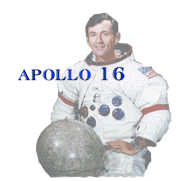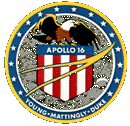
|

|
This page last updated |

|

|
This page last updated |

|
Apollo 16
AS-511
|
| 1 | 2 | 3 | 4 | 5 | 6 | 7 | 8 | 9 | 10 | 11 | 12 | 13 | 14 | |
| 15 | 16 | 17 | 18 | 19 | 20 | 21 | 22 | 23 | 24 | 25 | 26 | 27 | 28 | |
| 29 | 30 | 31 | 32 | 33 | 34 | 35 | 36 | 37 | 38 | 39 | 40 | 41 | 42 | Links |

Apollo 16 Crew to Conduct 4 New Experiments on Mission
KSC Spaceport News - April 6, 1972Four new scientific experiments are included in the 28 scheduled to be conducted by the Apollo 16 crew during their 12-day mission.
Two new experiments-cosmic ray detection and ultraviolet photography-are scheduled for Commander John Young and Lunar Module Pilot Charles Duke during their stay on the lunar surface, and two new biological experiments are scheduled for Lunar Module Pilot Kenneth Mattingly in orbit and enroute to and from the Moon.
The cosmic ray detection experiment involves installation of four sensitive plates on the exterior of the LM prior to launch. During the trip to the Moon the plates will record cosmic rays as they pass through the plates. One of the plates will be changed upon arrival on the lunar surface to register the rays, which originate from some source outside the solar system, reaching the lunar surface.
All plates will be returned to Earth for microscopic study to determine the types of particles moving through the plates and their directions of movement.
Discovery of new elements is considered possible as a result of this experiment.
An ultravioletcamera/spectrograph will be used by Young and Duke on the lunar surface to provide the first astronomical observations made from the Moon. The first object to be photographed will be the Earth for a study of its upper atmosphere and magnetosphere and their interaction with the solar wind.
Results of the UV camera experiments will be used to evaluate the Moon as a future site for an astronomical observatory.
An experiment to record microbial response in a space environment will be carried in the CM. Selected viruses, bacteria and fungi, none of them harmful to man, will be carried in small cubes in a Microbial Ecology Evaluation Device (MEED). Following Mattingly's retrieval of the exposed film from service module Scientific Instrument Module (SIM) bay cameras during his EVA enroute to Earth. the CSM's attitude will be changed so that the MEED will be exposed to direct sunlight for ten minutes to compare effects on the microbe cultures and study the possibility of mutations resulting from exposure to sunlight in space.
Another experiment, called Biostak, will involve the carrying of seeds and eggs in a packet to ascertain effects of cosmic rays in space. It is a passive experiment-the packet will not be touched during the mission.
Other lunar surface experiments include a passive seismic experiment similar to that carried on all previous lunar landing missions, which, when installed, will complete the lunar surface seismic network, and an active seismic experiment similar to that installed on the lunarsurface by the Apollo 14 crew. Grenades placed on the surface by the Apollo 14 crew, not as yet fired, and those to be installed by Young and Duke, will be fired later.
A lunar surface magnetometer, improved over those carried by Apollos 12 and 15; a heat flow experiment similar to that carried by Apollo 15, but with an improved drill; a lunar geology experiment similar to those of all previous missions, a portable magnetometer, a solar wind detection device and a soil mechanics experiment will also be carried to the Moon's surface.
Experiments to be carried in the SIM bay, essentially the same as those carried in Apollo 15, include gamma-ray, alpha-particle and mass spectrometers; an S-band transponder, an X-ray fluorescence experiment, a 24-inch panoramic camera, a three-inch mapping camera, a laser altimeter which provides altitude readings registered on exposed mapping camera film; and a subsatellite
The subsatellite, which released into lunar orbit prior to insertion of the CSM trans-Earth trajectory, will carry a particle measurement experiment, a magnetometer and an S-band transponder.
Photography will be one of the major responsibilities of CM pilot Mattingly as he orbits the Moon while Young and Duke are on the lunar surface, including photography of the lunar surface and ultraviolet photography of the Earth and Moon; and another Gegenschein photography experiment enroute to the Moon. A bistatic radar experiment, and a bone mineral measurement experiment are also installed in the CM.
|
|
| 1 | 2 | 3 | 4 | 5 | 6 | 7 | 8 | 9 | 10 | 11 | 12 | 13 | 14 | 15 | 16 | 17 | 18 | 19 | 20 | 21 | |
| 22 | 23 | 24 | 25 | 26 | 27 | 28 | 29 | 30 | 31 | 32 | 33 | 34 | 35 | 36 | 37 | 38 | 39 | 40 | 41 | 42 | Links |
Home Biography Missions Appearances Bibliography Site Map Critique this site! Other Astros
John W. Young - American & International Hero Title Page
Page created by Dana Holland - webmaster @ johnwyoung.org
Dana's Page
This site is for informational and educational purposes only. It is NOT sanctioned by John Young, NASA, or Navarro College.